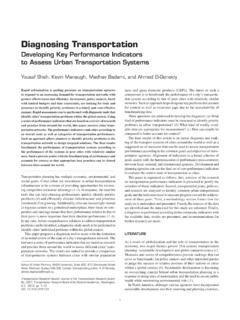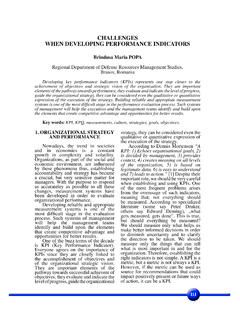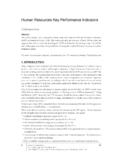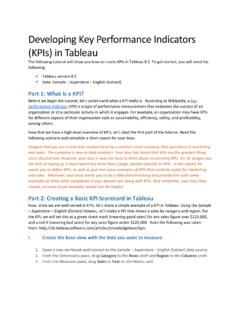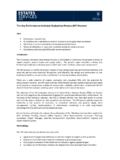Transcription of Diagnosing Transportation - McGill University
1 Diagnosing Transportation : developing key performance indicators To Assess Urban Transportation Systems Supervised Research Project Report Submitted in partial fulfillment of the Masters of Urban Planning degree Submitted by: Yousaf M. Shah Supervised by: Professor Ahmed El-Geneidy School of Urban Planning McGill University 26th July, 2012 Acknowledgements First and foremost, I would like to thank Professor Ahmed El-Geneidy for his availability and guidance during the development of this research paper. I am grateful to Kevin Manaugh, who offered to be a second reader under a tight timeframe and provided very helpful feedback. A special thank you is also reserved for Professor Madhav Badami, who helped in framing the initial research and theory behind the project.
2 Positive vibes go out to Brendan Rahman and Dea Van Lierop, who offered to read over my drafts and provided advice on both technical issues and writing. I d also like to extend my gratitude to Mr. Agarwal, who suggested the topic of this paper and provided the initial framework for the design of this project. A big thank you also goes to the Class of 2012, who are some of the most talented people I ve had the pleasure of studying and working with. Abstract Rapid urbanization is putting pressure on Transportation agencies to respond to increasing demand for greater access to services. In response, policy makers, faced with limited budgets and time constraints, are looking for tools and processes to identify priority problems in a timely and cost effective manner.
3 Rapid assessments can be performed using a diagnostic study that can identify cities individual problems within the global context. Using a series of performance indicators based on a review of research and practice from around the world, this paper assesses different cities Transportation networks. The performance indicators rank cities according to an overall score as well as different categories of Transportation performance . Such an approach allows planners to identify priority problems in the Transportation network and design targeted solutions. The final results benchmark the performance of Transportation systems according to peer cities with relatively similar sizes. Such a process assists in benchmarking performance while accounting for context, so that appropriate best practices can be shared between cities around the world.
4 Abr g L'urbanisation rapide exerce une pression sur les agences de transport afin qu elles r pondent la demande croissante d un plus grand acc s aux services. En r ponse, les d cideurs, confront s des budgets limit s et des contraintes de temps, sont la recherche d'outils et de processus pour identifier les priorit s de mani re efficace et rentable. L valuation rapide de ces priorit s peut tre effectu e l'aide de diagnostic permettant d'identifier les probl mes sp cifiques chaque ville en les pla ant dans un contexte mondial. R f rant une s rie d'indicateurs de performances bas e sur une revue de la litt rature et des exp riences internationales, cette tude se propose d valuer les r seaux de transport de diff rentes villes.
5 Les indicateurs de performance choisis permettront de classer les villes selon leurs r sultats g n raux ainsi que selon leur performance dans diff rentes cat gories sp cifiques. Une telle approche sera en mesure de faciliter la t che des planificateurs dans l'identification des priorit s d action afin d am lioration l acc s des services de transport dans une ville. Les r sultats finaux permettront galement de comparer les performances des r seaux de transport entre des villes de tailles relativement similaires selon un m me standard, facilitant ainsi l analyse comparative des performances tout en tenant compte du contexte dans lequel il s inscrit, de sorte que les meilleures pratiques puissent tre partag es entre les villes des quatre coins du monde.
6 Table of Contents Introduction .. 1 Literature Review .. 5 Methodology .. 13 Information and Data Sources .. 17 Policy and Research Analysis .. 25 Analysis and Assessment .. 35 Conclusion and Recommendations for Further 49 References .. 53 Appendix I: Complete list of Indicators in policy and research documents.. 58 Appendix II: Cities assessed according to the source of data used .. 61 Appendix III: Normalized Results .. 62 Appendix IV: Raw 64 List of Tables Table 1: Indicators from Transportation Policies and Plans .. 18 Table 2: Categories of performance Indicators .. 19 Table 3: Indicators from International Agencies and NGOs .. 20 Table 4: Indicators taken from Academic Research .. 21 Table 5: Goals in Urban Policy .. 25 Table 6: Selected Indicators per Goal and Frequency of Use.
7 27 Table 7: Final set of indicators to be used .. 33 Table 8: Population Groups .. 35 Table 9: Data for calculating Z-Scores and Normalized Scores .. 47 List of Figures Figure 1: Geographic distribution of selected cities .. 22 Figure 2: Rankings for Cities with fewer than 1 million people .. 36 Figure 3: Rankings for Cities with 1 to 2 million people .. 37 Figure 4: Rankings for cities with 2 to 5 million people .. 39 Figure 5: Rankings for cities with more than 5 million people .. 40 Figure 6: Cities ranked by Population and Cumulative Scores .. 42 Figure 7: Cities ranked by GDP per Capita and Cumulative Scores .. 44 Figure 8: City rankings by geographic distribution .. 46 Y. Shah 1 Introduction Despite pressure on governments to respond to rapidly increasing demand for greater access to services, policy makers do not always have the resources to undertake comprehensive research for informed assessments.
8 In response, there is a growing need for tools to identify priority problems in a short time and at a low cost (Leitmann & Program, 1993). These tools can then be used to develop a broad and strategic Transportation management plan. Additionally, as investment in transport infrastructure continues to be seen as a means of providing links towards competitive economic advantage (Dimitriou & Gakenheimer, 2011; Peters, Paaswell, & Berechman, 2008; Sandercock, 1998), the use of prioritization tools will also help planners identify how to best allocate infrastructure investment (Westfall & de Villa, 2001). However, before comprehensive solutions can be identified to address Transportation problems, a diagnostic study needs to be performed to identify cities individual problems within the global context.
9 The rationale for a diagnosis is premised upon the practice of identifying Transportation problems through the use of key performance indicators (KPI). Drawing on the concept of the wicked problems presented by Rittel and Webber (1973), the selection of KPI and how they are measured affects the nature of the problems identified. However, Transportation plans are often developed without taking into consideration such indicators. Plans may be attempting to alleviate symptoms of larger issues rather than the actual problems facing a city s transport infrastructure. This paper proposes a diagnostic tool to assist in developing an initial review of the current state of a city s Transportation network. The tool utilizes a series of performance Y.
10 Shah 2 indicators, based on research and practice from around the world, to assess different cities Transportation networks. The results rank cities and allow a comparison of Transportation systems between cities with similar conditions. The intent of such a comparison is to benchmark the performance of a city s Transportation system according to peer cities with relatively similar networks. This approach helps designate key problems that account for context. Comparisons between cities also help to integrate the concept of peer-learning into Transportation planning. One approach is South-South cooperation, an effective tool used by the World Bank to arrive at solutions for developing countries. As defined by the World Bank Institute, South-South cooperation is an exchange of expertise and resources between governments, organizations, and individuals in developing nations (The World Bank Institute, 2012).
